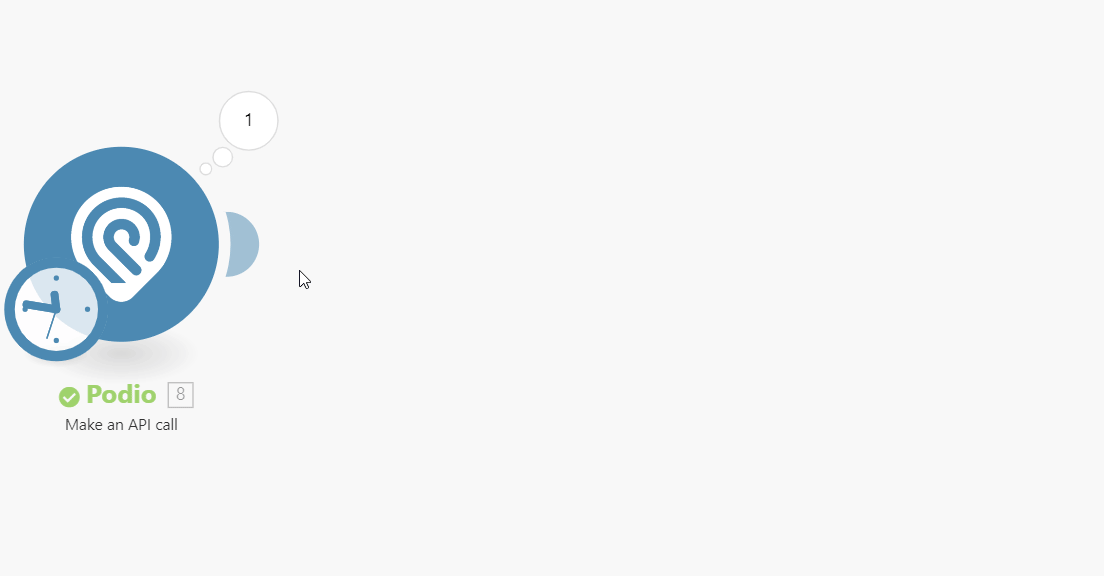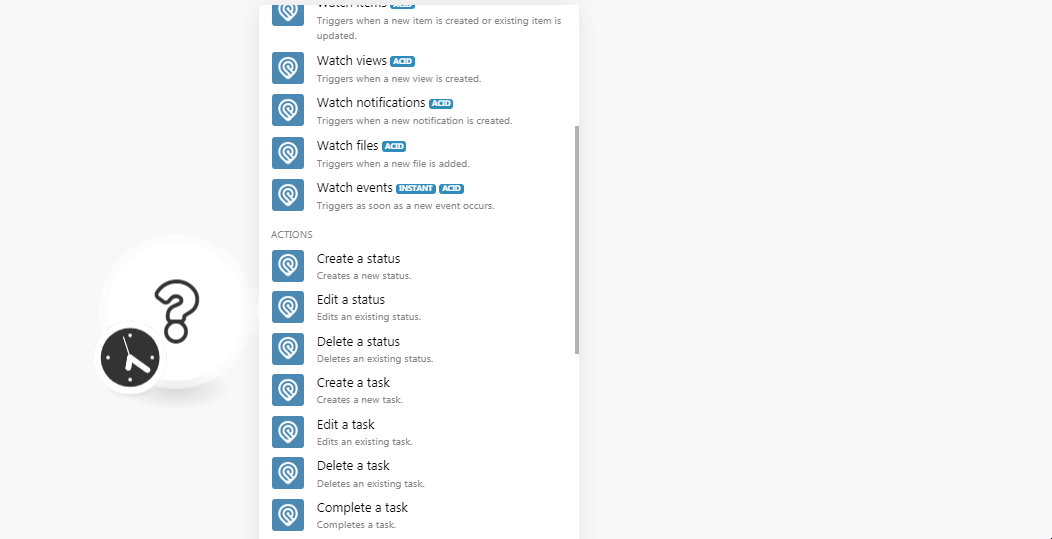- Podio
- Getting Started with Podio
- Connecting Podio to Boost.space Integrator
- Triggers
- Actions
- Create an App Item
- Update an App Item
- Delete an App Item
- Search for App Items
- Filter App Items
- Get App Item
- Create a Task
- Edit a Task
- Complete a Task
- Delete a Task
- Create a Comment
- Edit a Comment
- Delete a Comment
- Create a Status
- Edit a Status
- Delete a Status
- Attach a File
- Get App Field
- Get Contacts
- Make an API Call
- Example of Use - Get Task
| Active |
|---|
| This application does not need additional settings. So you can make connectionUnique, active service acces point to a network. There are different types of connections (API key, Oauth…). More only by using your login credentials or by following the instructions below . |
The Podio modulesThe module is an application or tool within the Boost.space system. The entire system is built on this concept of modularity. (module - Contacts) More allow you to watch, create, update, retrieve, comments, contacts, itemsItems are rows in records (order/request/invoice/purchase...), organizations, files, applications, statusCreate statuses for each module separately to create an ideal environment for efficient and consistent work. More, and tasks in your Podio account.
Prerequisites
-
A Podio account
In order to use Podio with Boost.spaceCentralization and synchronization platform, where you can organize and manage your data. More IntegratorPart of the Boost.space system, where you can create your connections and automate your processes. More, it is necessary to have a Podio account. If you do not have one, you can create a Podio account at podio.com/signup.
1. Go to Boost.space Integrator and open the Podio module’s Create a connection dialog.
2. In the Connection name field, enter a name for the connection and click Continue.
3. Confirm the access by clicking the Grant Access.
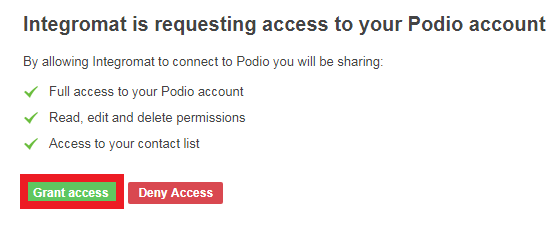
The connection has been established.
TriggersEvery scenario has a trigger, an event that starts your scenario. A scenario must have a trigger. There can only be one trigger for each scenario. When you create a new scenario, the first module you choose is your trigger for that scenario. Create a trigger by clicking on the empty module of a newly created scenario or moving the... when a new application is created.
|
Connection |
|
|
Organization ID |
Select the Organization ID whose applications you want to watch. |
|
Workspace |
Select the workspace whose applications you want to watch. |
|
Limit |
Set the number of returned apps Boost.space Integrator will return during one execution cycleA cycle is the operation and commit/rollback phases of scenario execution. A scenario may have one or more cycles (one is the default).. |
Triggers when a new comment is created.
|
Connection |
|
|
Object |
Select the object whose comments you want to watch:
|
|
ID |
Select the App Item ID / Task ID / Status ID whose comments you want to watch. |
|
Limit |
Set the number of returned apps Boost.space Integrator will return during one execution cycle. |
Triggers when a new contact is created.
|
Connection |
|
|
Limit |
Set the number of returned contacts Boost.space Integrator will return during one execution cycle. |
Triggers when a new file is added.
|
Connection |
|
|
Watch |
Select the option to watch the files:
|
|
Limit |
Set the number of returned files Boost.space Integrator will return during one execution cycle. |
|
Attached to |
Select the option whose attached files you want to watch:
|
Triggers when a new item is created or an existing item updated.
|
Connection |
|
|
Organization ID |
Select the Organization ID whose applications you want to watch. |
|
Workspace |
Select the workspace whose applications you want to watch. |
|
Application |
Select the application whose items you want to watch:
|
|
Watch |
Select the option to watch the items:
|
|
Limit |
Set the number of returned items Boost.space Integrator will return during one execution cycle. |
Triggers when a new notification is created.
|
Connection |
|
|
Limit |
Set the number of returned notifications Boost.space Integrator will return during one execution cycle. |
Triggers when a new organization is created.
|
Connection |
|
|
Limit |
Set the number of returned organizations Boost.space Integrator will return during one execution cycle. |
Triggers when a new task is created.
|
Connection |
|
|
Organization ID |
Select the Organization ID whose workspace tasks you want to watch. |
|
Workspace |
Select the workspace whose tasks you want to watch. |
|
Limit |
Set the number of returned tasks Boost.space Integrator will return during one execution cycle. |
Triggers when a new view is created.
|
Connection |
|
|
Limit |
Set the number of returned views Boost.space Integrator will return during one execution cycle. |
Triggers when a new workspace is created.
|
Connection |
|
|
Organization ID |
Select the Organization ID whose workspaces you want to watch. |
|
Limit |
Set the number of returned workspaces Boost.space Integrator will return during one execution cycle. |
Triggers as soon as a new event occurs.
![[Note]](https://docs.boost.space/wp-content/themes/bsdocs/docs-parser/HTML/css/image/note.png) |
Note |
|---|---|
|
You do not have to add the webhooksA webhook is a way for an app to send real-time information to a specific URL in response to certain events or triggers. in the Podio as it is automatically done for you once you add and save an instant triggerEvery scenario has a trigger, an event that starts your scenario. A scenario must have a trigger. There can only be one trigger for each scenario. When you create a new scenario, the first module you choose is your trigger for that scenario. Create a trigger by clicking on the empty module of a newly created scenario or moving the... moduleThe module is an application or tool within the Boost.space system. The entire system is built on this concept of modularity. (module - Contacts) More to your scenarioA specific connection between applications in which data can be transferred. Two types of scenarios: active/inactive. More. |
|
WebhookA webhook is a way for an app to send real-time information to a specific URL in response to certain events or triggers. Name |
Enter a name for the webhook. |
|
Connection |
|
|
Watched Object |
Select the object whose events you want to watch. |
|
Organization ID |
Select the Organization ID whose events you want to watch. |
|
Workspace |
Select the workspace of the organization whose events you want to watch. |
|
Application |
Select the applications whose events you want to watch. |
|
Event Type |
Select the event type:
|
|
Limit |
Set the number of returned events Boost.space Integrator will return during one execution cycle. |
Creates an app item.
|
Connection |
|
|
Organization |
Select the Organization ID for whose applications you want to create an application. |
|
Workspace |
Select the workspace to which you want to create an application. |
|
Application |
Select the application type you want to create and the option auto-populates the related fields to fill:
|
Updates an already existing app item.
|
Connection |
|
|
Organization |
Select the Organization ID for whose applications you want to create an application. |
|
Workspace |
Select the workspace to which you want to create an application. |
|
Application |
Select the application type you want to create and the option auto-populates the related fields to fill:
|
|
Item ID |
Enter the Application’s Item ID you want to update. |
Deletes an app item.
|
Connection |
|
|
Item ID |
Enter the application’s Item ID you want to delete. |
Returns app items matching the searched text.
|
Connection |
|
|
Organization |
Select the Organization ID whose application items you are searching for. |
|
Workspace |
Select the workspace whose application items you are searching for. |
|
Searched Text |
Enter the text or phrase to search item based on the specified text. |
|
Continue the execution of the route even if the module returns no results |
Select the checkbox to execute the scenario even if there are no results. |
|
Maximum number of returned items |
Set the number of returned items Boost.space Integrator will return during one execution cycle. |
Return items matching the specified criteria.
|
Connection |
|
|
Organization |
Select the Organization ID whose application items you are searching for. |
Retrieves an app item with a given ID.
|
Connection |
|
|
Organization |
Select the Organization ID for whose application items details you want to retrieve. |
|
Workspace |
Select the workspace whose application items details you want to retrieve. |
|
Application |
Select the application type:
|
|
Item ID |
Enter the Application’s Item ID whose details you want to retrieve. |
Creates a new task.
|
Connection |
|
|
Task Name |
Enter a name for the task. |
|
Description of the Task |
Enter the details of the task. |
|
Due Date |
Enter a date by when the task must be complete. |
|
ID of the userCan use the system on a limited basis based on the rights assigned by the admin. More who is assigned to the task |
Enter the User ID to whom you want to assign the task. |
Edits an existing task.
|
Connection |
|
|
Task ID |
Enter the Task ID whose details you want to update. |
|
Task Name |
Enter a name for the task. |
|
Description of the Task |
Enter the details of the task. |
|
Due Date |
Enter a date by when the task must be complete. |
|
ID of the user who is assigned to the task |
Enter the User ID to whom you want to assign the task. |
Completes a task.
|
Connection |
|
|
Task ID |
Enter the Task ID which you want to mark as complete. |
Deletes an existing task.
|
Connection |
|
|
Task ID |
Enter the Task ID you want to delete. |
Creates a new comment.
|
Connection |
|
|
Object |
Select the object for which you want to create a comment:
|
|
ID |
Select the App Item ID/ Task ID / Status ID to which you want to add a comment. |
|
Comment |
Enter the comment text. |
Edits an existing comment.
|
Connection |
|
|
Comment ID |
Enter the Comment ID which you want to edit. |
|
Comment |
Enter the new comment text. |
Deletes an existing comment.
|
Connection |
|
|
Comment ID |
Enter the Comment ID you want to delete. |
Creates a new status.
|
Connection |
|
|
Enter a Workspace |
Select the option to choose the workspace:
|
|
Organization ID |
Select the Organization ID for which you want to create a status. |
|
Workspace |
Select the workspace for which you want to create a status. |
|
Text |
Enter the status text. |
Edits an existing status.
|
Connection |
|
|
Status ID |
Enter the Status ID you want to edit. |
|
Text |
Enter the status text. |
Deletes an existing status.
|
Connection |
|
|
Status ID |
Enter the Status ID you want to delete. |
Attaches a file to a given object.
|
Connection |
|
|
Object |
Select the object type to which you want to attach the file. |
|
Object ID |
Enter the Object ID. |
|
File Name |
Enter the file name. For example, |
|
Data |
Enter the file data to the field or map the source of the file. |
Gets an app dropdown field and its values.
|
Connection |
|
|
Organization |
Select the Organization ID whose application items you are searching for. |
|
Workspace |
Select the workspace whose application field details you want to retrieve. |
|
Application |
Select the application whose field details you want to retrieve. |
|
Field |
Select the field whose details you want to retrieve. |
Retrieves a list of contacts.
|
Connection |
|
|
Limit |
Set the number of returned contacts Boost.space Integrator will return during one execution cycle. |
Makes a raw API call. The module allows you to make an arbitrary call using the existing connection.
|
Connection |
|
|
URL |
Enter a path relative to For the list of available endpoints, refer to the Podio API Documentation. |
|
Method |
Select the HTTP method you want to use: GET to retrieve information for an entry. POST to create a new entry. PUT to update/replace an existing entry. PATCH to make a partial entry update. DELETE to delete an entry. |
|
Headers |
Enter the desired request headers. You don’t have to add authorization headers; we already did that for you. |
|
Query String |
Enter the request query string. |
|
Body |
Enter the body content for your API call. |
The following API call returns the specified task details from your Podio account:
URL:/task/{{task_id}}
Method:GET
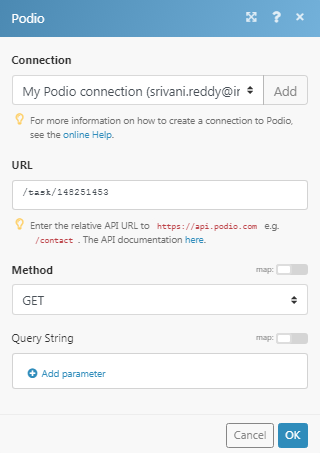
Matches of the search can be found in the module’s Output under BundleA bundle is a chunk of data and the basic unit for use with modules. A bundle consists of items, similar to how a bag may contain separate, individual items. More > Body > Response.In our example, task details were returned:
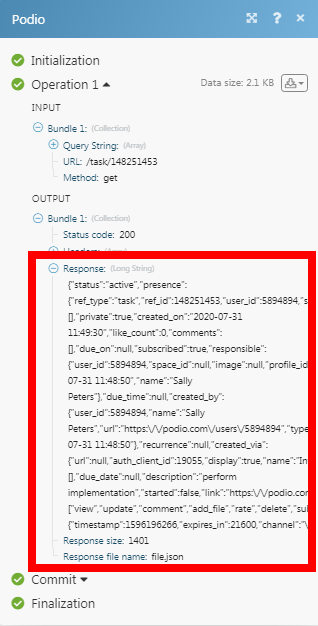
To convert the response details into standard JSON format, please map the response to the Parse JSONmodule.
